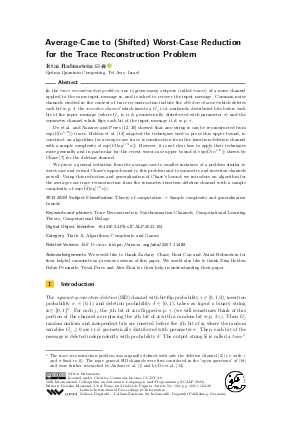@InProceedings{rubinstein:LIPIcs.ICALP.2023.102,
author = {Rubinstein, Ittai},
title = {{Average-Case to (Shifted) Worst-Case Reduction for the Trace Reconstruction Problem}},
booktitle = {50th International Colloquium on Automata, Languages, and Programming (ICALP 2023)},
pages = {102:1--102:20},
series = {Leibniz International Proceedings in Informatics (LIPIcs)},
ISBN = {978-3-95977-278-5},
ISSN = {1868-8969},
year = {2023},
volume = {261},
editor = {Etessami, Kousha and Feige, Uriel and Puppis, Gabriele},
publisher = {Schloss Dagstuhl -- Leibniz-Zentrum f{\"u}r Informatik},
address = {Dagstuhl, Germany},
URL = {https://drops.dagstuhl.de/entities/document/10.4230/LIPIcs.ICALP.2023.102},
URN = {urn:nbn:de:0030-drops-181542},
doi = {10.4230/LIPIcs.ICALP.2023.102},
annote = {Keywords: Trace Reconstruction, Synchronization Channels, Computational Learning Theory, Computational Biology}
}

 Creative Commons Attribution 4.0 International license
Creative Commons Attribution 4.0 International license



















